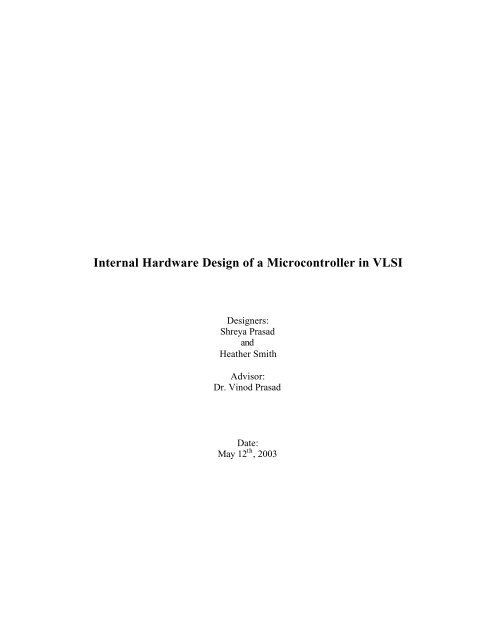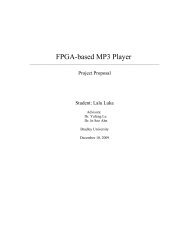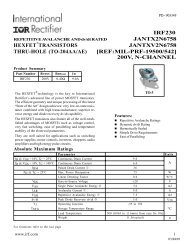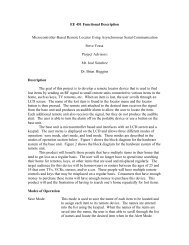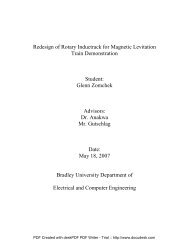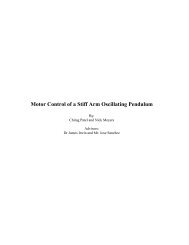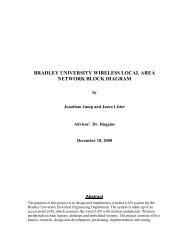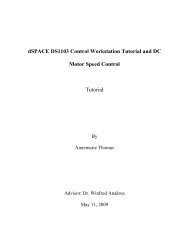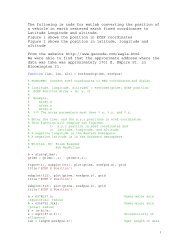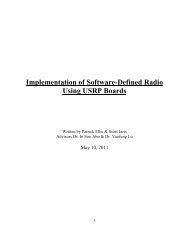Internal Hardware Design of a Microcontroller in VLSI
Internal Hardware Design of a Microcontroller in VLSI
Internal Hardware Design of a Microcontroller in VLSI
You also want an ePaper? Increase the reach of your titles
YUMPU automatically turns print PDFs into web optimized ePapers that Google loves.
<strong>Internal</strong> <strong>Hardware</strong> <strong>Design</strong> <strong>of</strong> a <strong>Microcontroller</strong> <strong>in</strong> <strong>VLSI</strong><br />
<strong>Design</strong>ers:<br />
Shreya Prasad<br />
and<br />
Heather Smith<br />
Advisor:<br />
Dr. V<strong>in</strong>od Prasad<br />
Date:<br />
May 12 th , 2003
Abstract<br />
This project describes the design and implementation <strong>of</strong> some <strong>of</strong> the <strong>in</strong>ternal hardware<br />
components <strong>of</strong> a microcontroller. The subsystems designed are the fundamental<br />
hardware components necessary to create the 16-bit timer’s <strong>in</strong>put capture and output<br />
compare modes, the <strong>in</strong>dex register, and other systems. The subsystems designed were the<br />
clock controller, the 16-bit timer, the register controller, the register, and the comparator.<br />
The project eng<strong>in</strong>eers implemented their system us<strong>in</strong>g Xil<strong>in</strong>x to test their logic and <strong>VLSI</strong><br />
to construct the gates. VHDL code was written <strong>in</strong> order to implement the project onto an<br />
FPGA board.
Table <strong>of</strong> Contents<br />
Introduction 4<br />
System Description 4<br />
Block Diagrams 5<br />
Clock Controller Subsystem 5<br />
16-bit Timer Subsystem 5<br />
Register Controller Subsystem 6<br />
Register Subsystem 7<br />
Comparator Subsystem 7<br />
Analysis <strong>of</strong> Results 8<br />
Gate-Level <strong>Design</strong> <strong>in</strong> Xil<strong>in</strong>x 8<br />
<strong>VLSI</strong> Circuit Diagrams <strong>in</strong> L-Edit 13<br />
Computer Simulations <strong>of</strong> <strong>VLSI</strong> <strong>Design</strong> <strong>in</strong> PSpice 18<br />
VHDL S<strong>of</strong>tware <strong>Design</strong> 23<br />
Conclusions 24<br />
Appendix: VHDL Subsystem Code and Simulation 25
Introduction<br />
The purpose <strong>of</strong> the Capstone project is to design some <strong>of</strong> the <strong>in</strong>ternal components<br />
<strong>of</strong> a microcontroller. The subsystems designed are the fundamental hardware<br />
components necessary to create the 16-bit timer’s <strong>in</strong>put capture and output compare<br />
modes, the <strong>in</strong>dex register, and other systems. The delays created by the system can run<br />
real-time systems and <strong>in</strong>terrupts. These delays are important <strong>in</strong> creat<strong>in</strong>g PWM signals<br />
and also <strong>in</strong> the operation <strong>of</strong> the microcontroller.<br />
System Description<br />
The designers used a top-down approach. Figure 1 shows the complete system<br />
block diagram. The system has five ma<strong>in</strong> subsystems: the clock controller, the timer, the<br />
register controller, the register, and the comparator. The user <strong>in</strong>puts are the clock pulse,<br />
the 8-bit value <strong>in</strong>to the accumulator, the 1-bit enable and the 2-bit control value to the<br />
register controller, the 1-bit enable and the 2-bit control value to the clock controller, the<br />
enable to the 16-bit timer, and various resets for each subsystem. The user outputs are a<br />
1-bit value from each <strong>of</strong> the four comparators and a 1-bit overflow from the timer.<br />
Figure 1: System Block Diagram
Block Diagrams<br />
Clock Controller Subsystem<br />
The clock controller accepts from the user a clock pulse <strong>in</strong>put and an enable <strong>in</strong>put<br />
to turn on the counter, as shown <strong>in</strong> Figure 2. The user’s clock pulse is used as the clock<br />
pulse <strong>in</strong>put to each <strong>of</strong> the three D flip-flops <strong>in</strong> the counter. The outputs <strong>of</strong> the three D<br />
flip-flops are four clock pulses, which are one time, two times, four times, and eight<br />
times the period <strong>of</strong> the orig<strong>in</strong>al pulse. The user also will <strong>in</strong>put a 2-bit control value to<br />
select which <strong>of</strong> the four pulses will be used as the system clock by a 4:1 multiplexor.<br />
16-bit Timer Subsystem<br />
Figure 2: Clock Controller Subsystem Block Diagram<br />
As can be seen <strong>in</strong> Figure 3, the <strong>in</strong>puts to the timer subsystem are the enable and<br />
the reset from the user and the clock from the clock controller. The outputs are the lower<br />
8 bits <strong>of</strong> the 16-bit timer value, which <strong>in</strong>put to the comparator subsystem, and the<br />
overflow bit, which is an external carry out bit. The timer operates as a 16-bit counter.<br />
After FFFFh has been reached, it sets the carry out bit high for one clock pulse and<br />
restarts at 0000h.
Register Controller Subsystem<br />
Figure 3: 16-bit Timer Subsystem Block Diagram<br />
The user will <strong>in</strong>put a 2-bit value that tells the controller which <strong>of</strong> the four registers<br />
should store the accumulator value. The clock <strong>in</strong>put to the subsystem comes from the<br />
clock controller. Figure 4 shows how the register controller’s four outputs are connected<br />
to the clocks <strong>of</strong> each <strong>of</strong> the four registers. The register controller selects which register<br />
will receive the accumulator value by turn<strong>in</strong>g that register’s clock on and leav<strong>in</strong>g all <strong>of</strong><br />
the other registers’ clock <strong>in</strong>puts low. If the enable <strong>in</strong>put to the controller is low, none <strong>of</strong><br />
the registers will receive the accumulator value.<br />
Figure 4: Register Controller and Register Subsystems Block Diagram
Register Subsystem<br />
The 8-bit accumulator is where the user enters the value to be stored. The<br />
accumulator consists <strong>of</strong> eight D flip-flops, each hold<strong>in</strong>g a s<strong>in</strong>gle bit. The accumulator, as<br />
shown <strong>in</strong> Figure 4, can then transfer the value <strong>in</strong>to any <strong>of</strong> the four registers depend<strong>in</strong>g on<br />
which register’s clock is turned on by the register controller.<br />
The register subsystem is closely related to the register controller as just<br />
described. Figure 4 shows the four 8-bit registers, which receive the clock pulse from the<br />
register controller. The <strong>in</strong>puts to the register subsystem are the 8-bit accumulator value,<br />
the clock from the register controller, and a reset for each register. Each <strong>of</strong> the four<br />
registers conta<strong>in</strong>s eight D flip-flops, mak<strong>in</strong>g a total <strong>of</strong> thirty-two D flip-flops for the<br />
register subsystem. The subsystem stores 8-bit values received from the accumulator<br />
until the user enters a new value <strong>in</strong>to the register specified by the register controller. In<br />
this case, the new value would simply replace the previous value. The subsystem also<br />
outputs each <strong>of</strong> the 8-bit values to the comparator.<br />
Comparator Subsystem<br />
The comparator subsystem has two <strong>in</strong>puts: an 8-bit value from each <strong>of</strong> the<br />
registers <strong>in</strong> the register subsystem and the lower 8-bit value from the timer subsystem.<br />
The output <strong>of</strong> each comparator is a one-bit compare value, as shown <strong>in</strong> Figure 5. There<br />
are four comparators, one for each <strong>of</strong> the four registers. In this subsystem, the 8-bit value<br />
from each register is compared to the lower 8-bits from the timer. If the two eight bit<br />
values are the same, the 1-bit output is logic ‘1.’ Otherwise, the output is logic ‘0.’
Analysis <strong>of</strong> Results<br />
Figure 5: Comparator Subsystem Block Diagram<br />
The gate-level schematics <strong>of</strong> the subsystems were designed and simulated us<strong>in</strong>g<br />
Xil<strong>in</strong>x Foundation 4. L-Edit Pro was used to create the transistor-level design us<strong>in</strong>g<br />
<strong>VLSI</strong>. The extract file generated from each L-Edit design was edited and tested <strong>in</strong><br />
PSpice. VHDL code was written and tested for each subsystem us<strong>in</strong>g ModelSim. The<br />
system was made <strong>in</strong>to one project <strong>in</strong> Xil<strong>in</strong>x, L-Edit, and ModelSim. The designers<br />
implemented the complete VHDL project onto an FPGA board us<strong>in</strong>g Xil<strong>in</strong>x Foundation.<br />
Gate-Level <strong>Design</strong> <strong>in</strong> Xil<strong>in</strong>x<br />
The design began at the gate-level where the digital logic could be easily tested<br />
and debugged before mov<strong>in</strong>g onto a <strong>VLSI</strong> design <strong>in</strong> L-Edit, which is a more complex<br />
work<strong>in</strong>g environment. Each subsystem was designed separately <strong>in</strong> a schematic file and<br />
simulated. Once each subsystem was proved to be work<strong>in</strong>g, the subsystems were then<br />
turned <strong>in</strong>to macros, which was done by creat<strong>in</strong>g a s<strong>in</strong>gle block entity from a schematic<br />
file. These blocks show only the <strong>in</strong>puts and outputs <strong>of</strong> each schematic and simplify the<br />
layout when connect<strong>in</strong>g the subsystems together, as shown <strong>in</strong> Figure 10.
The clock controller <strong>in</strong> Figure 6 has a 3-bit counter on the left half and a 4:1<br />
multiplexor on the right half. The user <strong>in</strong>puts a clock pulse and the subsystem outputs the<br />
clock pulse selected by the 2-bit user control value on the bottom <strong>of</strong> Figure 6.<br />
Figure 6: Gate-Level <strong>Design</strong> <strong>of</strong> Clock Controller Subsystem<br />
Figure 7 shows a 4-bit counter design. The timer subsystem consists <strong>of</strong> four <strong>of</strong><br />
these to make the 16-bit timer. The f<strong>in</strong>al AND gate on the bottom outputs the carry out<br />
bit. The design will have 16 fall<strong>in</strong>g-edge D flip-flops and a reset.<br />
Figure 7: Gate-Level <strong>Design</strong> <strong>of</strong> 4-bit Timer
The register controller subsystem accepts a 2-bit controller value, which selects<br />
which <strong>of</strong> the four output bits will take the <strong>in</strong>put clock pulse. This is done by us<strong>in</strong>g a 2:4<br />
decoder, as shown <strong>in</strong> Figure 7.<br />
Figure 7: Gate-Level <strong>Design</strong> <strong>of</strong> the Register Controller<br />
Each <strong>of</strong> the four registers and the accumulator use eight NOR gate, fall<strong>in</strong>g-edge<br />
triggered D flip-flops as shown <strong>in</strong> Figure 8. The designers also added another <strong>in</strong>put to<br />
the NOR gate that outputs the Q value. This third <strong>in</strong>put was used as the flip-flop’s reset.<br />
Figure 8: Gate-Level <strong>Design</strong> <strong>of</strong> the NOR Gate D Flip-flop
As shown <strong>in</strong> Figure 9, the comparator design used XOR gates to compare the<br />
register and timer values bit by bit. A NAND gate was used to verify if all eight <strong>of</strong> the<br />
bits were the same.<br />
Complete System<br />
Figure 9: Gate-Level <strong>Design</strong> <strong>of</strong> the Comparator Subsystem<br />
The complete system is shown <strong>in</strong> Figure 10. The designers used macros to create<br />
blocks for various subsystems.
Figure 10: System Gate-Level <strong>Design</strong> <strong>in</strong> Xil<strong>in</strong>x
<strong>VLSI</strong> Circuit Diagrams <strong>in</strong> L-Edit<br />
The <strong>VLSI</strong> system design was accomplished us<strong>in</strong>g the s<strong>of</strong>tware package L-Edit.<br />
All <strong>of</strong> the subsystems <strong>in</strong> <strong>VLSI</strong> are based on the gate-level designs shown <strong>in</strong> Figures 6<br />
through 10. The D flip-flop, shown <strong>in</strong> Figure 11, uses six NOR gates. This design uses<br />
the least number <strong>of</strong> transistors, which is important because the D flip-flop is <strong>in</strong>tegral <strong>in</strong><br />
three <strong>of</strong> the subsystems: the clock controller, the 16-bit timer, and the register.<br />
Figure 11: D Flip-Flop <strong>Design</strong> <strong>in</strong> <strong>VLSI</strong><br />
The clock controller subsystem is shown <strong>in</strong> Figure 12. The 3-bit counter is on the<br />
left side and the 4:1 multiplexor is on the right.
Figure 12: Clock Controller Subsystem <strong>in</strong> <strong>VLSI</strong><br />
Figure 13 shows the 16-bit timer subsystem design <strong>in</strong> <strong>VLSI</strong>. Each <strong>of</strong> the four<br />
columns represents four bits <strong>of</strong> the counter with the most significant bits on the left hand<br />
side.
Figure 13: 16-bit Timer Subsystem <strong>in</strong> <strong>VLSI</strong><br />
An 8-bit register is made up <strong>of</strong> 8 D flip-flops. As shown <strong>in</strong> Figure 14, there are<br />
four flip-flops on the top row and four on the bottom. In a s<strong>in</strong>gle register all the flip-flops<br />
have their clocks and resets tied together. The four registers and the accumulator use this<br />
design.<br />
Figure 14: 8-bit Register <strong>Design</strong> <strong>in</strong> <strong>VLSI</strong>
The comparator subsystem <strong>in</strong> L-Edit is shown <strong>in</strong> Figure 15. The eight two-<strong>in</strong>put<br />
XOR gates are shown to the left, and their outputs go <strong>in</strong>to the eight-<strong>in</strong>put NOR gate<br />
shown to the right.<br />
Figure 15: Comparator Subsystem <strong>in</strong> <strong>VLSI</strong>
The <strong>VLSI</strong> design for the complete subsystem is shown <strong>in</strong> Figure 16.<br />
Figure 16: Complete System <strong>Design</strong> <strong>in</strong> <strong>VLSI</strong>
Computer Simulations <strong>of</strong> <strong>VLSI</strong> <strong>Design</strong> <strong>in</strong> PSpice<br />
PSpice was used to simulate the L-Edit designs. The PSpice simulation for each<br />
subsystem is shown below. The system simulation is also shown.<br />
Clock Controller Subsystem:<br />
The <strong>in</strong>put clock pulse is the bottom plot <strong>in</strong> Figure 17. This subsystem outputs one<br />
<strong>of</strong> four clock pulses to the system depend<strong>in</strong>g on the 2-bit controller <strong>in</strong>put value, which are<br />
the two middle plots. The work<strong>in</strong>g output plot is displayed on the top l<strong>in</strong>e.<br />
Timer Subsystem:<br />
Figure 17: Clock Controller Output Plot <strong>in</strong> PSpice<br />
The 16-bit timer subsystem works as a 16-bit counter. Figure 18 shows it<br />
work<strong>in</strong>g as a 4-bit counter s<strong>in</strong>ce it would be excessive to display all sixteen output bits.<br />
The <strong>in</strong>put clock is the bottom plot. Here the carry out bit from the eleventh bit is set high<br />
to enable the last four bits to act as if the first four bits. Test<strong>in</strong>g was done <strong>in</strong> a similar<br />
manner by simulat<strong>in</strong>g the system <strong>in</strong> four 4-bit <strong>in</strong>crements. This was the f<strong>in</strong>al test,
show<strong>in</strong>g the most significant four bits <strong>of</strong> the timer and the carry out bit, which is the top<br />
most plot <strong>in</strong> Figure 18.<br />
Register Controller Subsystem:<br />
Figure 18: 16-bit Timer Output Plot <strong>in</strong> PSpice<br />
The simulation shown <strong>in</strong> Figure 19 shows how one <strong>of</strong> the four outputs, shown as<br />
the top four plots, takes the <strong>in</strong>put clock pulse depend<strong>in</strong>g on the 2-bit controller value. If<br />
the enable is low, none <strong>of</strong> the four outputs will take the clock pulse, as shown dur<strong>in</strong>g the<br />
first half <strong>of</strong> the simulation.<br />
Figure 19: Register Controller Plot <strong>in</strong> PSpice
Register Subsystem:<br />
The register subsystem consists <strong>of</strong> four 8-bit registers. Each bit is a s<strong>in</strong>gle D flip-<br />
flop, which is shown <strong>in</strong> Figure 20. Reset, the bottom plot, must be low for the output, the<br />
top plot, to take the <strong>in</strong>put, which is the second to top plot. The output only follows the<br />
<strong>in</strong>put on the fall<strong>in</strong>g edge <strong>of</strong> the clock, which is the second to bottom plot.<br />
In the subsystem, the resets and clocks <strong>of</strong> all the D flip-flops <strong>of</strong> the same register<br />
area tied together.<br />
Comparator Subsystem:<br />
Figure 20: D Flip-Flop Used by the Register Subsystem <strong>in</strong> PSpice<br />
In Figure 21, the output at the top goes high when all four <strong>of</strong> the <strong>in</strong>put plots<br />
shown are the same. The bottom two <strong>in</strong>puts would come from the timer and the middle<br />
two <strong>in</strong>put plots would come from a register. The system compares two sets <strong>of</strong> eight bits,<br />
but for simplicity, the designers used the same to describe multiple <strong>in</strong>put variables.
Complete System:<br />
Figure 21: Comparator Subsystem <strong>in</strong> PSpice<br />
To test the complete system, the designers first needed to <strong>in</strong>itialize all <strong>of</strong> the<br />
subsystems by sett<strong>in</strong>g reset high. Once this was done, the timer, as shown <strong>in</strong> Figure 20,<br />
started <strong>in</strong>crement<strong>in</strong>g from 0000h.<br />
Figure 22: Timer Output <strong>of</strong> Complete System <strong>in</strong> PSpice<br />
Next, values were entered <strong>in</strong>to the accumulator and the register controller<br />
assigned these values to the appropriate register.
Figure 23: Register 2 Outputs and Compare 2 Output<br />
The designers also stored values <strong>in</strong>to register 3 and plotted the output <strong>of</strong><br />
comparator 3 to test if the system is work<strong>in</strong>g. This is shown <strong>in</strong> Figure 24, which can be<br />
compared to the timer values <strong>in</strong> Figure 24. The outputs <strong>of</strong> comparator 0 and 1 were also<br />
checked but s<strong>in</strong>ce the registers’ values rema<strong>in</strong>ed at all zero, the compare output only went<br />
high when the timer first started at all zeros.<br />
Figure 24: Register 3 Outputs and Compare 3 Output
VHDL S<strong>of</strong>tware <strong>Design</strong><br />
The VHDL code for each <strong>of</strong> the five subsystems is shown <strong>in</strong> the appendix.<br />
Components were created <strong>in</strong> <strong>in</strong>dividual files. The components were comb<strong>in</strong>ed us<strong>in</strong>g the<br />
gate level design from Xil<strong>in</strong>x. Port maps were used to call each component and def<strong>in</strong>e<br />
the <strong>in</strong>puts and outputs. The code for the entire system is shown <strong>in</strong> Figure 25. The<br />
simulation is shown <strong>in</strong> Figure 26.<br />
library ieee;<br />
use ieee.std_logic_1164.all;<br />
entity system is<br />
port( t: <strong>in</strong> std_logic_vector(15 downto 0);<br />
Q1,Q2,Q3,Q4: <strong>in</strong> std_logic_vector(7 downto 0);<br />
Out1,Out2,Out3,Out4: out std_logic);<br />
end system;<br />
architecture sgp <strong>of</strong> system is<br />
component clkcontim<br />
port (etimer,eclkcon,restimer,resclkcon,clk<strong>in</strong>: <strong>in</strong> std_logic;<br />
conclk: <strong>in</strong> std_logic_vector (1 downto 0);<br />
t: out std_logic_vector (15 downto 0);<br />
co: out std_logic);<br />
end component;<br />
component reg<br />
port (Da: <strong>in</strong> std_logic_vector(7 downto 0);<br />
a: <strong>in</strong> std_logic_vector(1 downto 0);<br />
clk,rst,enable: <strong>in</strong> std_logic;<br />
Q1,Q2,Q3,Q4:out std_logic_vector(7 downto 0));<br />
end component;<br />
component comp<br />
port (r:<strong>in</strong> std_logic_vector(7 downto 0);<br />
t:<strong>in</strong> std_logic_vector(15 downto 0);<br />
z:out std_logic);<br />
end component;<br />
beg<strong>in</strong><br />
g15: comp port map(Q1,t,Out1);<br />
g16: comp port map(Q2,t,Out2);<br />
g17: comp port map(Q3,t,Out3);<br />
g18: comp port map(Q4,t,Out4);<br />
end sgp;<br />
Figure 24: VHDL code for System<br />
Figure 25: Simulation <strong>of</strong> System code
Conclusion<br />
The Capstone Project was successful. The designers successfully created the<br />
<strong>in</strong>ternal components <strong>in</strong> Xil<strong>in</strong>x, L-EDIT, and VHDL that they had set out to do. They<br />
were able to implement their VHDL design onto an FPGA board successfully and<br />
demonstrate it at the Technology Expo. The designers now have a better understand<strong>in</strong>g<br />
<strong>of</strong> the <strong>in</strong>ternals <strong>of</strong> a microcontroller.
Appendix: VHDL Subsystem Code and Simulation<br />
The five subsystems are shown with their simulation output.<br />
Comparator subsystem:<br />
library ieee;<br />
use ieee.std_logic_1164.all;<br />
entity comp is<br />
port(r,t:<strong>in</strong> std_logic_vector(7 downto 0);<br />
z:out std_logic);<br />
end comp;<br />
architecture sgp <strong>of</strong> comp is<br />
component xor_gate is<br />
port(x,y: <strong>in</strong> std_logic;<br />
z: out std_logic);<br />
end component;<br />
component nor8_gate<br />
port(<strong>in</strong>put: <strong>in</strong> std_logic_vector(7 downto 0);<br />
output:out std_logic);<br />
end component;<br />
signal s: std_logic_vector(7 downto 0);<br />
beg<strong>in</strong><br />
g1:xor_gate port map(r(0),t(0),s(0));<br />
g2:xor_gate port map(r(1),t(1),s(1));<br />
g3:xor_gate port map(r(2),t(2),s(2));<br />
g4:xor_gate port map(r(3),t(3),s(3));<br />
g5:xor_gate port map(r(4),t(4),s(4));<br />
g6:xor_gate port map(r(5),t(5),s(5));<br />
g7:xor_gate port map(r(6),t(6),s(6));<br />
g8:xor_gate port map(r(7),t(7),s(7));<br />
g9:nor8_gate port map(s,z);<br />
end sgp;<br />
Figure A1: VHDL code for Comparator subsystem<br />
Figure A2: Simulation for Comparator
Figure A3: Simulation for Comparator (zoomed <strong>in</strong>)<br />
Register Subsystem and Register Controller Subsystem:<br />
library ieee;<br />
use ieee.std_logic_1164.all;<br />
entity reg is<br />
port(Da: <strong>in</strong> std_logic_vector(7 downto 0);<br />
a: <strong>in</strong> std_logic_vector(1 downto 0);<br />
clk,rst,enable: <strong>in</strong> std_logic;<br />
Q1,Q2,Q3,Q4:out std_logic_vector(7 downto 0));<br />
end reg;<br />
architecture sgp <strong>of</strong> reg is<br />
component reg8<br />
port(D:<strong>in</strong> std_logic_vector(7 downto 0);<br />
clk,rst: <strong>in</strong> std_logic;<br />
Q: out std_logic_vector(7 downto 0));<br />
end component;<br />
component regcon<br />
port(a: <strong>in</strong> std_logic_vector (1 downto 0);<br />
enable,clk: <strong>in</strong> std_logic;<br />
clock_out: out std_logic_vector (3 downto 0));<br />
end component;<br />
component acc<br />
port(Da: <strong>in</strong> std_logic_vector(7 downto 0);<br />
clk,rst:<strong>in</strong> std_logic;<br />
Qa:out std_logic_vector(7 downto 0));<br />
end component;<br />
signal clock_out: std_logic_vector(3 downto 0);<br />
signal Qa: std_logic_vector(7 downto 0);<br />
beg<strong>in</strong><br />
g9:reg8 port map(D=>Qa,clk=>clock_out(0),rst => rst,Q=>Q1);<br />
g10:reg8 port map(D=>Qa,clk=>clock_out(1),rst => rst,Q=>Q2);<br />
g11:reg8 port map(D=>Qa,clk=>clock_out(2),rst => rst,Q=>Q3);<br />
g12:reg8 port map(D=>Qa,clk=>clock_out(3),rst => rst,Q=>Q4);<br />
g13:acc port map(Da=>Da,clk=>clk,rst=>rst, Qa=>Qa);<br />
g14:regcon port map(a=>a, clk=>clk, enable=>enable,<br />
clock_out=>clock_out);<br />
end sgp;<br />
Figure A4: VHDL code for Register subsystem
Clock Controller Subsystem:<br />
library ieee;<br />
use ieee.std_logic_1164.all;<br />
Figure A5: Simulation for Register<br />
entity clkcon is<br />
port (eclkcon,clk<strong>in</strong>,resclkcon: <strong>in</strong> std_logic;<br />
conclk: <strong>in</strong> std_logic_vector (1 downto 0);<br />
d,q: <strong>in</strong>out std_logic_vector (2 downto 0);<br />
clk: out std_logic);<br />
end clkcon;<br />
architecture rtl <strong>of</strong> clkcon is<br />
component and2<br />
port (x,y: <strong>in</strong> std_logic;<br />
z: out std_logic);<br />
end component;<br />
component xor_gate<br />
port (x,y: <strong>in</strong> std_logic;<br />
z: out std_logic);<br />
end component;<br />
component dff<br />
port(D,clk,rst: <strong>in</strong> std_logic;<br />
Q: out std_logic);<br />
end component;<br />
component not1<br />
port(x: <strong>in</strong> std_logic;<br />
z: out std_logic);<br />
end component;<br />
component nand3<br />
port (w,x,y: <strong>in</strong> std_logic;<br />
z: out std_logic);<br />
end component;<br />
component nand4<br />
port (v,w,x,y: <strong>in</strong> std_logic;<br />
z: out std_logic);<br />
end component;<br />
signal e,f: std_logic;<br />
signal na0,na1: std_logic;<br />
signal g,h,i,j: std_logic;
eg<strong>in</strong><br />
g1: xor_gate port map (eclkcon,q(0),d(0));<br />
g2: and2 port map (eclkcon,q(0),e);<br />
g3: dff port map (d(0),clk<strong>in</strong>,resclkcon,q(0));<br />
g4: xor_gate port map (e,q(1),d(1));<br />
g5: and2 port map (e,q(1),f);<br />
g6: dff port map (d(1),clk<strong>in</strong>,resclkcon,q(1));<br />
g7: xor_gate port map (f,q(2),d(2));<br />
g9: dff port map (d(2),clk<strong>in</strong>,resclkcon,q(2));<br />
g10: not1 port map (conclk(0),na0);<br />
g11: not1 port map (conclk(1),na1);<br />
g12: nand3 port map (clk<strong>in</strong>,na1,na0,g);<br />
g13: nand3 port map (q(0),na1,conclk(0),h);<br />
g14: nand3 port map (q(1),conclk(1),na0,i);<br />
g15: nand3 port map (q(2),conclk(1),conclk(0),j);<br />
g16: nand4 port map (g,h,i,j,clk);<br />
end rtl;<br />
Timer:<br />
library ieee;<br />
use ieee.std_logic_1164.all;<br />
Figure A6: VHDL code for Clock Controller<br />
Figure A7: Simulation for Clock Controller<br />
entity timer is<br />
port (etimer,clk,restimer: <strong>in</strong> std_logic;<br />
co: out std_logic;<br />
t: out std_logic_vector (15 downto 0));<br />
end timer;<br />
architecture rtl <strong>of</strong> timer is<br />
component and2<br />
port (x,y: <strong>in</strong> std_logic;<br />
z: out std_logic);<br />
end component;<br />
component xor_gate<br />
port (x,y: <strong>in</strong> std_logic;<br />
z: out std_logic);<br />
end component;<br />
component dff<br />
port(D,clk,rst: <strong>in</strong> std_logic;<br />
Q: out std_logic);<br />
end component;
signal d,q: std_logic_vector (15 downto 0);<br />
signal a,b,c,d1,e,f,g,h,i,j,k,l,n,m,o: std_logic;<br />
beg<strong>in</strong><br />
g1: xor_gate port map (etimer,q(0),d(0));<br />
g2: and2 port map (etimer,q(0),a);<br />
g3: dff port map (d(0),clk,restimer,q(0));<br />
g4: xor_gate port map (a,q(1),d(1));<br />
g5: and2 port map (a,q(1),b);<br />
g6: dff port map (d(1),clk,restimer,q(1));<br />
g7: xor_gate port map (b,q(2),d(2));<br />
g8: and2 port map (b,q(2),c);<br />
g9: dff port map (d(2),clk,restimer,q(2));<br />
g10: xor_gate port map (c,q(3),d(3));<br />
g11: and2 port map (c,q(3),d1);<br />
g12: dff port map (d(3),clk,restimer,q(3));<br />
g13: xor_gate port map (d1,q(4),d(4));<br />
g14: and2 port map (d1,q(4),e);<br />
g15: dff port map (d(4),clk,restimer,q(4));<br />
g16: xor_gate port map (e,q(5),d(5));<br />
g17: and2 port map (e,q(5),f);<br />
g18: dff port map (d(5),clk,restimer,q(5));<br />
g19: xor_gate port map (f,q(6),d(6));<br />
g20: and2 port map (f,q(6),g);<br />
g21: dff port map (d(6),clk,restimer,q(6));<br />
g22: xor_gate port map (g,q(7),d(7));<br />
g23: and2 port map (g,q(7),h);<br />
g24: dff port map (d(7),clk,restimer,q(7));<br />
g25: xor_gate port map (h,q(8),d(8));<br />
g26: and2 port map (h,q(8),i);<br />
g27: dff port map (d(8),clk,restimer,q(8));<br />
g28: xor_gate port map (i,q(9),d(9));<br />
g29: and2 port map (i,q(9),j);<br />
g30: dff port map (d(9),clk,restimer,q(9));<br />
g31: xor_gate port map (j,q(10),d(10));<br />
g32: and2 port map (j,q(10),k);<br />
g33: dff port map (d(10),clk,restimer,q(10));<br />
g34: xor_gate port map (k,q(11),d(11));<br />
g35: and2 port map (k,q(11),l);<br />
g36: dff port map (d(11),clk,restimer,q(11));<br />
g37: xor_gate port map (l,q(12),d(12));<br />
g38: and2 port map (l,q(12),m);<br />
g39: dff port map (d(12),clk,restimer,q(12));<br />
g40: xor_gate port map (m,q(13),d(13));<br />
g41: and2 port map (m,q(13),n);<br />
g42: dff port map (d(13),clk,restimer,q(13));<br />
g43: xor_gate port map (n,q(14),d(14));<br />
g44: and2 port map (n,q(14),o);<br />
g45: dff port map (d(14),clk,restimer,q(14));<br />
g46: xor_gate port map (o,q(15),d(15));<br />
g47: and2 port map (o,q(15),co);<br />
g48: dff port map (d(15),clk,restimer,q(15));
process (q)<br />
beg<strong>in</strong><br />
for i <strong>in</strong> 0 to 15 loop<br />
t(i)


